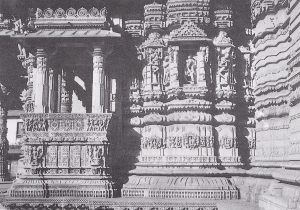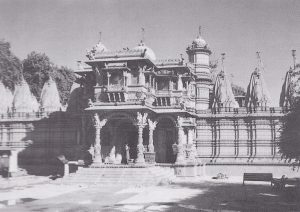Ahmedabad
 Though founded by a Muslim, Sultan Ahmad Shah, in 1411, Ahmedabad has more Jaina temples than mosques within its historic city wall. Astonishingly, a guide published by the Archaeological Survey of India (2nd ed. 1992), entitled AHMADABAD, does not mention a single Jaina monument. A Parshvanatha temple which was built by Shantidas Jhaveri, a wealthy Jaina merchant of Ahmedabad, was confiscated by Aurangzeb, then governor of Gujarat, in 1645 and turned into a mosque.
Though founded by a Muslim, Sultan Ahmad Shah, in 1411, Ahmedabad has more Jaina temples than mosques within its historic city wall. Astonishingly, a guide published by the Archaeological Survey of India (2nd ed. 1992), entitled AHMADABAD, does not mention a single Jaina monument. A Parshvanatha temple which was built by Shantidas Jhaveri, a wealthy Jaina merchant of Ahmedabad, was confiscated by Aurangzeb, then governor of Gujarat, in 1645 and turned into a mosque.
Later, by order of emperor Shah Jahan, the father of Aurangzep, the temple was given back to Shantidas Jhaveri. However, because of the desecration and rebuilding, it could not be used again as a Jaina shrine.
A frequent sight in the narrow streets of Ahmedabad’s inner city are small pavilions placed on pillars and mostly built of wood. Many of them are artistically modelled and carved. They are Jaina ‘inventions’ meant for feeding birds and simply called parabadis (pigeon-houses). Another peculiarity, found in Ahmedabad’s Jaina temples, are large underground chambers designed for worship.
To undertake a pilgrimage to Sammeta Shikhara, that most sacred mountain in far away Bihar, is – and especially was before the age of modern transportation – beyond the means of many Gujarati Jainas. To alleviate this handicap, Jaina laymen erected a fitting substitute: a temple that has in its centre a huge replica of the holy mountain. Known as Sammetshikara temple, it has become a popular sight; also for tourists.
Bihar, is – and especially was before the age of modern transportation – beyond the means of many Gujarati Jainas. To alleviate this handicap, Jaina laymen erected a fitting substitute: a temple that has in its centre a huge replica of the holy mountain. Known as Sammetshikara temple, it has become a popular sight; also for tourists.
Ahmedabad. Karnavati Tirtha, so named by the local Jainas, but because of its lo cation in the Hatheesing Vadi (vadi suburb). outside the Delhi Gate, it is called Hatheesing Jaina Temple, especially in guides and maps. With its two storeys, fifty-two devakulikas and several underground chambers it is the largest Jaina temple in the city. It is sacred to Dharmava natha, the 15th Tirthankara.
Building began in the second quarter of the nineteenth century by Sheth Hatheesing, a Jaina layman; when he died, his wife Harakunvar spend a huge amount of money to have the temple completed. The festive inauguration, lasting for twenty-one days, took place in 1848.
It is not easily located. A knowledgeable rikshaw-driver is required; hiring a taxi would not be a good choice, because of the narrow lanes. Once there, more Jaina temples can be discoverd on foot in this area.
Portico of the Hatheesing Temple. Detail of the lower façade seen from the east. Sandstone.
I found the Jains to be such warm, welcoming, and fundamentally well-adjusted and happy people that I felt that I had to pursue the religious roots of their obvious wellbeing.
John E. Cort (1989:4)